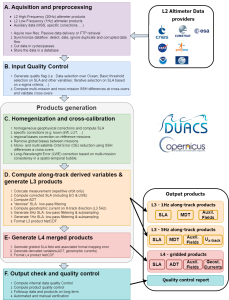The DUACS system takes in input Level 2 (L2) altimeter products and processes them to generate homogenous along-track Level-3 (L3) and multi-mission merged gridded Level-4 (L4) products. It comprises of two components: Near Real Time (NRT) and Delayed-Time (DT also named REP or MY).
In NRT, the system’s primary objective is to provide operational applications with directly usable high-quality altimeter data from all missions available. Since November 29th 2023, the DUACS system has been upgraded in order to process both L3 1 Hz and 5 Hz products:
In DT, the primary objective is to maintain a consistent and user-friendly altimeter database using the state-of-the-art recommendations from the altimetry community. The DT products/datasets are extended in time on a quarterly basis. Therefore, these datasets cover 1993 up to five-nine months before present. These datasets benefit from the highest quality altimeter measurements and geophysical corrections, and are produced with a unique system (no changes in time in the set up, extended in time using the same system) to minimize the risk of quality loss or spurious signals appearing over time.
The following figure provides an overview of the system, where processing sequences can be divided into seven main steps:
- Acquisition and preprocessing
- Input data quality control
- Multi-mission homogenization
- Along-track L3 products generation
- Merged L4 products generation
- Final quality control

The processing is similar for NRT and DT components. Below, we set out a description of the different steps of the processing. The reader can also see Pujol et al., (2016, 2023) for complementary details.
Figure: Overview of the DUACS system processing.
|
Acquisition and data selection Processing flow management
|
L2 upstream data
Description of measurements used as input of the DUACS system |
Homogenization and cross-calibration
Overview of homogeneization and standardization during the flow management |
Along-track (L3) products generation
description of generation steps |
| Merged gridded (L4) products generation
description of generation steps |
Final quality control | System version changes
DUACS NRT and MY system impacting version changes |
To read more about the DUACS processing, you can also see Pujol et al, 2016